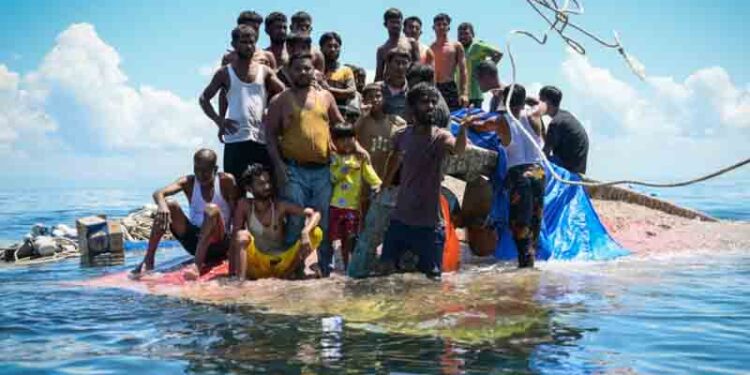Introduction: A Maritime Tragedy Unfolds
A devastating maritime accident occurred off the coast of the renowned Indonesian tourist island of Bali, where a passenger boat carrying 65 people capsized in rough seas. The tragedy has left at least 43 individuals missing, while rescue teams have managed to save 22 passengers so far. The incident has sparked national concern and international attention, highlighting the perils of sea travel during unpredictable weather conditions.
The Incident: What Happened Near Bali?
According to various foreign news agencies, the ill-fated vessel was ferrying passengers across a route popular among tourists and local commuters alike. The boat encountered treacherous weather, including powerful waves and gusty winds, which led to its sinking. The boat was reported to have been moderately sized and capable of carrying dozens of passengers.
Among the 65 people onboard were women, children, and possibly tourists visiting the scenic islands of Indonesia. Witnesses and survivors recounted a sudden change in sea conditions that overwhelmed the boat, giving little time for response or evacuation.
Rescue Operations Underway
In the aftermath of the accident, Indonesian rescue agencies quickly mobilized. The National Search and Rescue Agency (Basarnas), along with local authorities and volunteer organizations, deployed boats, helicopters, and divers to locate the missing passengers.
So far, 22 people have been rescued alive from the waters, many of whom were found clinging to debris or floating with the help of life jackets. The survivors are receiving medical treatment and psychological support. The fate of the remaining 43 passengers remains uncertain, and search operations are ongoing.
Divers have been facing challenges due to low visibility, rough waters, and scattered wreckage. Despite these conditions, rescue teams remain committed to continuing their search efforts.
Weather Conditions and Warnings
Authorities have cited severe weather as the primary cause of the accident. Indonesia’s Meteorological, Climatological, and Geophysical Agency (BMKG) had previously issued warnings regarding high waves and strong winds in the Bali region.
Such conditions are common during the transitional period between monsoon seasons, when the sea becomes particularly unpredictable. Maritime transport operators are generally advised to exercise extreme caution or avoid sailing during these times.
Public Safety Advisory and Government Response
Following the tragedy, the local government has urged the public to refrain from coastal travel and avoid boarding boats until weather conditions stabilize.
An official statement from the Bali regional administration confirmed that a full investigation into the cause of the incident has been ordered. Authorities intend to review the safety protocols of maritime operators, examine the seaworthiness of vessels, and ensure that passenger boats adhere strictly to safety regulations such as carrying adequate life vests and maintaining communication equipment.
The Indonesian Ministry of Transportation has also expressed condolences to the victims’ families and vowed to tighten regulations on passenger water transport.
Historical Context: Not the First Tragedy
Indonesia, an archipelago of more than 17,000 islands, relies heavily on water transport. Unfortunately, the country has a history of maritime accidents, many of which have been attributed to overcrowding, poor maintenance of boats, and sudden adverse weather.
One of the most tragic incidents occurred in 2018 when a ferry sank in Lake Toba, resulting in the deaths of more than 150 people. This recent accident near Bali underscores the ongoing challenges the country faces in ensuring maritime safety.
Human Toll and Emotional Impact
As families await news of their loved ones, emotions are running high. Local hospitals and temporary shelters have been set up to accommodate survivors and provide support to those affected.
Social media platforms have been flooded with messages of support, prayers, and calls for improved safety standards. Local religious leaders have also held prayer ceremonies for the missing individuals, hoping for their safe return.
International Reactions and Tourism Concerns
The incident has drawn international concern, especially since Bali is a globally recognized tourist destination that welcomes millions of visitors each year. Several foreign embassies have contacted local authorities to inquire about the nationalities of the passengers and offer assistance.
Tourism operators in Bali fear the tragedy might negatively impact travel confidence. However, many stress that such incidents, while heartbreaking, are rare and that ongoing safety reforms will aim to prevent future occurrences.
Ongoing Investigations and Future Measures
Investigators are expected to examine the boat’s condition, the captain’s decisions, and adherence to safety protocols. Preliminary findings suggest that weather played a key role, but accountability regarding operational oversight and regulatory compliance will also be reviewed.
Maritime safety experts have called for improved real-time weather monitoring systems, mandatory safety drills, and stricter enforcement of maritime laws. Public campaigns to educate both operators and passengers on sea travel safety may also be introduced.
Conclusion: A Nation in Mourning, a Call for Action
The sinking of the passenger boat near Bali has left Indonesia in mourning and sparked urgent calls for reform. With 43 people still missing, the nation watches anxiously as rescue efforts continue. While the sea remains a vital lifeline for millions in the island nation, this tragedy is a stark reminder of the risks involved and the need for unwavering attention to maritime safety.
Authorities, citizens, and the global community now look to the ongoing investigation and subsequent policy reforms to ensure that such a heartbreaking event is not repeated.

























